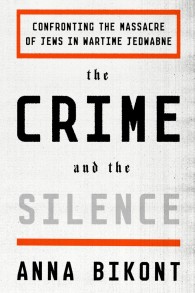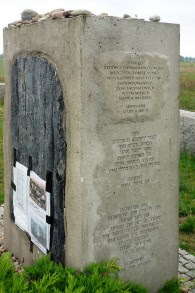Michal Kaminski
the Polish Zionist & anti-Semite that Jewish Chronicle Editor Stephen Pollard Just
Loves
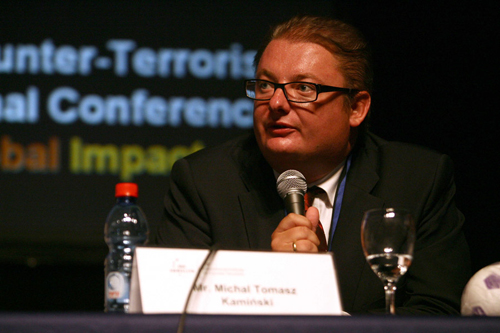 |
| The ECR Group Chairman Michał Kamiński speaking to the Global Counter-Terrorism Conference in Herzliya, Israel, September 2009. |
Michal Kaminski is ardently pro-Israeli.
In 2009 he was a guest speaker at the World Summit on Counter Terrorism:Terrorism’s Global Impact – ICT’s 9th International Conference at Herzliya in Israel. Kaminski did the usual rounds in Israel,
including paying homage to the dead of the holocaust at the Yad Vashem Holocaust
Propaganda Museum in Jerusalem. Yad
Vashem seems, over the years, to have been host to a number of anti-Semites, former
Nazis and assorted racists. John
Vorster, former Prime Minister of
Apartheid South Africa, was another visitor to Yad Vashem when visiting Israel in
April 1976.
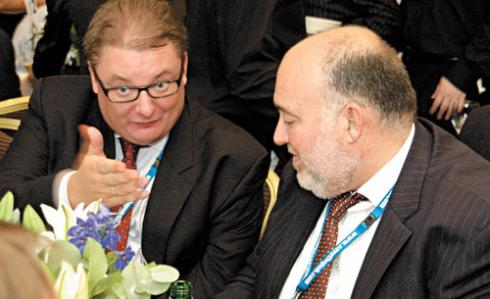 |
| Michal Kaminski talks to Israeli ambassador to the UK Ron Prosor during the Conservative Friends of Israel lunch at the Tory Party Conference 2009 |
Other keen visitors included a group of Russian neo-Nazis, who were the
guests of Aryeh Eldad and Ayoob Kara, two Likud MKs. Then there was the lovely story of a group of Israeli
children who were on a visit to Yad Vashem when they spotted a group of Arab
women there. They promptly started abusing
them. Clearly the children understood the message of Yad Vashem very well. Zionism’s
use of the holocaust is not to warn against the dangers of racism but to
render Israel’s use of racism immune to criticism. Yad Vashem – Israeli Jewish Teenagers AbuseVisiting Arab Women as Whores and Sluts
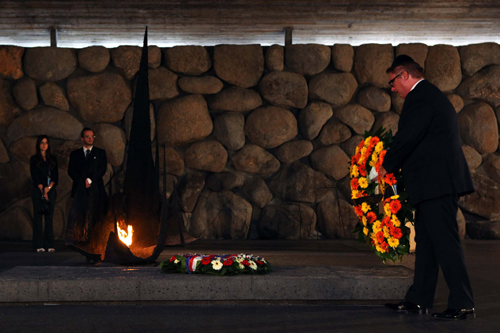 |
| ECR Group Chairman Michał Kamiński does what all anti-Semites do: he visits Yad Vashem Holocaust Memorial in Jerusalem, Israel, September 2009 |
However, when a Yad Vashem guide, Itamar Shapira, pointed out that Yad Vashem was established near the site of
the massacre of the Palestinian village Deir Yassin (now Givat Shaul), he was immediately
fired. Clearly he didn’t understand that
empathy with the Palestinians was not the message that Yad Vashem wanted to
convey. As their spokesman explained:‘The
institution’s position is that the Holocaust cannot be politicized or equated
with any other event.’ Yad Vashem Fires Employee Who Compared Holocaust toNakba
In an article Does supporting Israel make you a friend of the Jews? Mehdi
Hassan pointed out that Stephen Pollard had a strange piece in the Daily
Telegraph:
‘In a surprising and misconceived attempt
to defend (!) Polish MEP Michal Kaminski from accusations
of anti-Semitism, the editor of the Jewish Chronicle ends up making this rather bizarre point’ that “Far from being an anti-Semite, Mr Kaminski
is about as pro-Israeli an MEP as exists.”
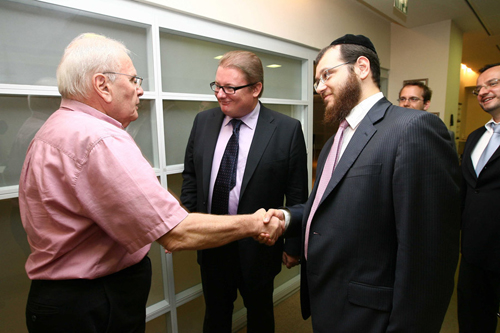 |
| The ECR Group Chairman Michał Kamiński with Dr Oded Eran, director of the Institute for National Security Studies in Israel, Israel, September 2009. |
As we all know, being an anti-Semite hardly disqualifies you as a Zionist. On the contrary it is a positive boon. As Israeli novellist and ideologue, A B
Yehoshua pointed out, in a talk to the Union of Jewish Students ‘
“Anti-Zionism
is not the product of the non-Jews.
On the contrary, the Gentiles
have always encouraged Zionism,
hoping that it would help to
rid them of the Jews in their midst. Even today, in a perverse way, a real anti-Semite
must be a Zionist. ” [Jewish Chronicle 22.1.82.]
Kaminski is a far- Right Polish MEP who opposed a national apology for the
massacre of Jews by Poles at Jedwabne, in his constituency, in 1941. The massacre in Jedwabne was the subject of a book by Polish-Jewish
historian Jan Tomasz Gross.[Neighbours: The Destruction of the Jewish Community
in Jedwabne, Poland, May 2000] It led to a national apology in 2001,
which Kaminski – an anti-Semite who is ardently pro-Zionist opposed. Stephen Pollard, ex-editor of Richard
Desmond’s Daily Express (a paper with
a record second only to the Daily Mail
in its hostility to Jewish refugees from Nazism) and now editor of the fast
fading Jewish Chronicle leapt to Kaminski’s defence.
In a bizarre op-Ed piece ‘David Miliband’s insult to Michal Kaminski is contemptible’
Pollard defended Kaminski in the Jewish Chronicle (1.10.09.) denying that
he had said that he would apologise only if someone “from the Jewish side” apologises for what “the Jews” did during the
Soviet occupation of eastern Poland from 1939 to 1941. Mr Kaminski flatly
denies this, and no one has yet produced a shred of serious evidence to
contradict him.”
Nine days later Pollard had to eat humble pie. In a comment piece for the Guardian, Pollard explained that Kaminski, in an interview with the Jewish Chronicle, that ‘there were acts of collaboration by Jewish people with the Soviet army when the Soviet army came to Poland … If you are asking the Polish nation to apologise for the crime made in Jedwabne, you would have to require the whole Jewish nation to apologise for what some Jewish communists did in Eastern Poland.” Poland’s Kaminski is not an antisemite: he’s a friend to Jews 1.10.09.
and who, if they collaborated with the Soviet Union did so because of Poland’s pre-existing anti-Semitism and fears for their lives, should have apologised. Then and only then would Kaminski consider
the question of an apology for burning the Jewish residents of Jedwabne alive
in a barn. Such is the company that
Pollard keeps. Of course Pollard was
keen to sniff out any hint of holocaust denial in Jeremy Corbyn. Even if it meant accepting the word of a holocaust
denier, Paul Eisen. Allegations of being
seen in the company of a holocaust denier is one thing, justifying the holocaust
is entirely different! Such is the
torturous logic of Pollard.
None of which prevented Pollard claiming in a Guardian CIF
piece (9.10.09.) that ‘Poland’s Kaminski is not an antisemite: he’s a friend to
Jews’. Indeed Kaminski is ‘one of the
greatest friends to the Jews in a town [Brussels] where antisemitism and a
visceral loathing of Israel are rife.’ http://www.theguardian.com/commentisfree/2009/oct/09/michal-kaminski-antisemitism
Bikont’s book ‘The Crime and the Silence’ which was originally published in
2004 and won the European Book Prize in 2011.
It has only recently been published in English. In an article in The Times of Israel, Anna suggests that Gross’s estimate of 300
dead may be an understimate and that as many as 900 Jews perished in the
flames.
belief that the murders were carried out by the poor and working-class are
wrong. ‘“There is a mythology out there
that the people who committed these crimes in Jedwabne were the poor and the
marginalized. Sure, there were also some people who were criminals who joined
in on the pogroms. But it was not organized by them. It was organized by the
local nationalistic Polish elites.” That
ties in with the fact that the main anti-Semitic groups in pre-war Polish were groups
like the Endeks and middle-class Polish university students. The Polish working-class voted for the Polish
Socialist Party which allied with the anti-Zionist Bund in the local authority
elections in 1938 and jointly fought against the pogromists.
whether you support Israel not whether you hate Jews.
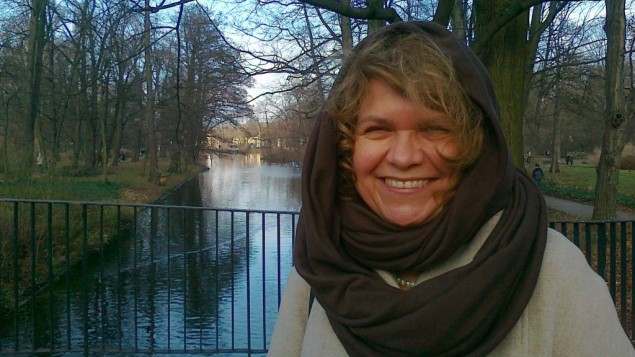 |
| Author Anna Bikont (Marcel Lozinski) |
Jedwabne’s Jews
and the Silence,’ journalist Anna Bikont sheds more light on the WWII massacre
of hundreds of Jews in occupied Poland
— In 2001, American historian Jan T. Gross set off a maelstrom of passionate
historical debate upon the publication of his book about the massacre of
hundreds of Jews during World War II, “Neighbors: The Destruction of the Jewish
Community in Jedwabne, Poland.” There were already numerous history books about
WWII’s brutal atrocities, but what set Gross’s book apart was its revelation
that these murders were not committed by the Nazis, but by the Poles
themselves.
this came as a shock to the world at large, years prior to “Neighbors”
publication, Polish-Jewish journalist Anna Bikont had been eager to report on
the crimes of Jedwabne. But her editor, Adam Michnik — one of Poland’s most
prominent Jewish writers and public intellectuals — didn’t want her to write
the story.
the time he was afraid because Poland was coming into the European Union and
NATO,” says Bikont, who helped found the left-wing newspaper Gazeta Wyborcza in
1989. “He thought this could promote an anti-Polish feeling with our European
neighbors, and that it was better not to write about it.”
also told me he didn’t believe so many people could be burnt in a barn, that it
simply wasn’t possible,” she tells The Times of Israel.
Jews were burned. But also many were shot one-by-one when they tried to hide.
So it’s very difficult to give an exact figure’
on Bikont’s extensive research, on July 10, 1941, the Jews of Jedwabne, a town
in northeast Poland, were herded into a barn and burned alive by their
Christian neighbors. The numbers of Jews murdered in the massacre has been
widely contested over the last few decades, but Bikont believes it’s likely to
be between 600 and 900.
Jews were burned. But also many were shot one-by-one when they tried to hide.
So it’s very difficult to give an exact figure,” she says.
part of her research surrounding that fateful day, Bikont interviewed the few
survivors from Europe, the United States, South America and Israel, and scoured
museums and national archives for written testimonies from people who survived
the war.
in Polish in 2004, “The Crime and The Silence: Confronting the Massacre of Jews
in Wartime Jedwabne” is a mixture of journalistic memoir and historical
analyses. It includes in-depth interviews from both the victims and those who
carried out the crimes.
book was re-published in French as “Le Crime et le Silence” in 2011 and won the
European Book Prize. It has recently become available in English for the first
time.
tells The Times of Israel that to properly understand how hatred against the
Jews manifested so intensely before the war and the Nazi occupation, one must
understand the connections between anti-Semitism and the Catholic Church.
is a very Catholic country, so the Catholic Church has had a huge impact on the
anti-Semitism that happened before the war, especially in east Poland in places
like Jedwabne,” she says.
the 1930s, with anti-Semitism raging across Europe, Bikont claims Polish
Catholics organized their entire social fabric around a deep mistrust and
hatred for the Jews.
children at the time would play anti-Semitic games such as the ‘Jew is the
thief,’” she explains. “So the Church taught Poles to have hostility and
contempt for Jews from early childhood.”
Poland’s mixed ‘blessing’
documents in her book how the Soviet occupation of wartime Poland also played
an important role in stirring up a strong anti-Semitic feeling, especially in
Jedwabne.
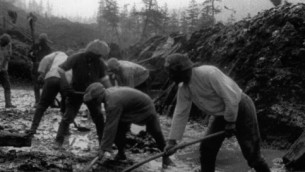 |
| The ‘Road of Bones’ constructed by inmates of the Soviet Gulag prison camps, including those of Polish citizenship. (public domain, via wikipedia) |
1939, both Nazi Germany and Soviet Russia invaded Poland, carving up the
country between them. The two occupying armies coordinated their efforts
against Poland until 1941’s Operation Barbarossa in which Hitler invaded the
Soviet Union, causing a complete shift in their relationships.
“the reign of terror,” the Soviet occupation destroyed the entire fabric of
social life built up by the Jewish community for centuries — the Jewish
municipal government was liquidated, Hebrew schools were closed, Yom Kippur
became a normal work day, political parties were dissolved and Zionist
activists were put on deportation lists.
the occupation was beneficial for Jews too, says Bikont. Many began to
experience equal rights for the first time in their lives and were given the
right to attend public school, to study, or to pursue professional careers in
medicine or education.
young Jews were particularly happy about the Soviets coming into Poland,” says
Bikont. “But when the Poles saw these Jews who had a normal life, that was not
full of humiliation, they really resented that. So hatred for Jews from the
Poles became far greater in the Soviet times.”
this time, many Poles were involved in the Soviet underground, where Poles
often betrayed other Poles. But, Bikont says, it was easier for many to say
that it was the Jews who denounced the Poles, so it didn’t look like Poles were
betraying each other.
were given the blame for a lot of things in these paranoid and suspicious
times,” she says.
helps to explain why the Jews, who were systematically rounded up to be torched
alive in the barn on July 10, 1941, were paraded around the marketplace in
Jedwabne beforehand. Crucially, though, they were made to carry a statue of
Bolshevik Revolution leader Vladimir Lenin, just before they perished. This was
seen both as a sign of humiliation, and to indicate Jewish-Soviet
collaboration.
Soviet iconography was extremely significant in representing feelings of
far-right Polish nationalism at the time, says Bikont.
of the propaganda was anti-Bolshevik propaganda. So the Polish nationalists
wanted to associate Jews with this statue of Lenin and to make these links
between Jews and communists,” she says.
all of the accounts that Bikont heard — both directly from her own research and
from secondary sources about the Jedwabne massacre — the names of Zygmunt
Laudański and Jerzy Laudański were always mentioned as the most active
participants in the crime.
brothers were sentenced to prison for the massacre. Zygmunt was sentenced to 12
years, but served just six, while Jerzy served just eight of a 15-year
sentence.
part of her research Bikont interviewed both brothers.
was the most horrible thing I have ever had to do in my career,” she says,
looking extremely distressed as she thinks back to the interviews.
brothers seemed very content in what they saw as achievements in their lives,”
Bikont tells The Times of Israel. “I saw that they were happy remembering how
they raped and killed Jewish women. They showed no remorse in these interviews
and they were completely cynical.”
though both brothers served time in a communist prison, Bikont says after their
release they were greeted as heroes in their local community.
is very difficult to think about for a Polish person, to be both a victim and a
perpetrator at the same time’
Laudański brothers were liberated because most people who were in the prison
were involved in anti-communist activities. It’s very difficult for Polish people
to admit to any of these things, because all the time during the war the
narrative was the same: that it was the Germans who committed the crimes, and
not the Poles, who were always seen as the victims.”
Many
people in Jedwabne think that the Germans ordered the Polish to carry out these
crimes, Bikont notes. But she says it’s untrue.
is very difficult to think about for a Polish person, to be both a victim and a
perpetrator at the same time. In Poland especially because we are used to
thinking about ourselves as a nation of victims throughout history. This is why
I think it’s so difficult for Poles to admit what happened in Jedwabne.”
Jan Gross’s book, “Neighbors,” the historian writes that the murderers of the
Jedwabne massacre were ordinary people. But Bikont believes that such a
description has led to many academics and journalists claiming, falsely, that
it was the Polish working class who predominately carried out the murders.
are used to thinking about ourselves as a nation of victims throughout history’
her book Biknot quotes a prominent Polish sociologist, Antoni Selek, who wrote
on this period of history that “the most active participants in the atrocity
were from the lower rungs of the social hierarchy, unsettled, unfettered by bonds
of family.”
is simply not true,” says Bikont. “There is a mythology out there that the
people who committed these crimes in Jedwabne were the poor and the
marginalized. Sure, there were also some people who were criminals who joined
in on the pogroms. But it was not organized by them. It was organized by the
local nationalistic Polish elites.”
